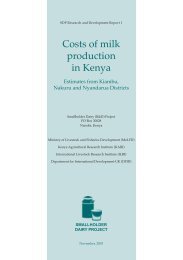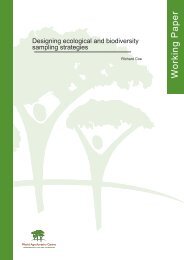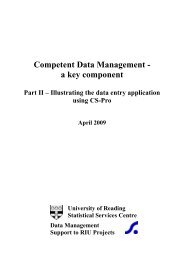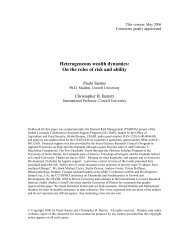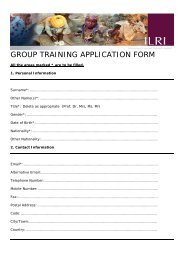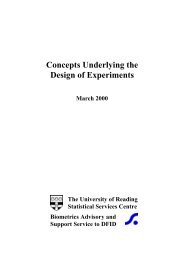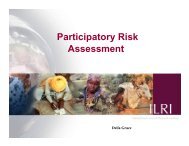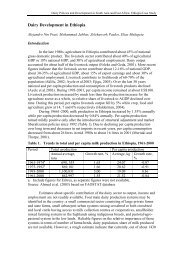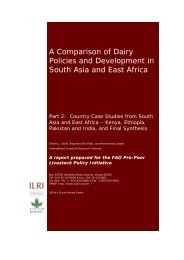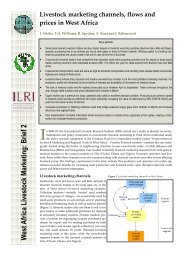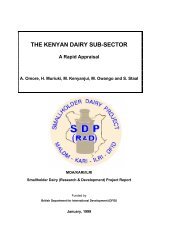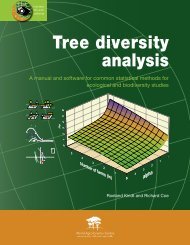Improvement of Livestock Production in Crop-Animal Systems in ...
Improvement of Livestock Production in Crop-Animal Systems in ...
Improvement of Livestock Production in Crop-Animal Systems in ...
You also want an ePaper? Increase the reach of your titles
YUMPU automatically turns print PDFs into web optimized ePapers that Google loves.
large areas <strong>of</strong> forests (3.4 million ha), and only produces 2.0% <strong>of</strong> national rice production (average yields2.1 t/ha). Rice is irrigated <strong>in</strong> the valleys, but upland rice is grown at higher elevations <strong>in</strong> shift<strong>in</strong>g cultivationsystems. In the SR zone, rice yields average 2.6 t/ha and account for only 4.5% <strong>of</strong> national production. Othercrops <strong>of</strong> importance <strong>in</strong>clude rubber, fruit, tea and c<strong>of</strong>fee. Cashew nut, black pepper, soyabean, peanut,mungbean, cowpea, banana, sugar-cane, cassava and sweet potato are also grown. Other crops such asp<strong>in</strong>eapple and cassava are grown under rubber before the canopy closes. On the grey and red soils <strong>in</strong> LongAn and Dong Nai prov<strong>in</strong>ces, ra<strong>in</strong>fed lowland rice is grown <strong>in</strong> rotation with peanut, or <strong>in</strong> association withmaize/mungbean/tobacco, maize/mungbean, or maize/soyabean/tobacco. Other cropp<strong>in</strong>g patterns <strong>in</strong>cludevegetables–peanut–rice, peanut–peanut–rice, vegetables–rice–rice, peanut–rice–rice and monoculture rice.The MD zone is the most important irrigated rice area <strong>in</strong> Vietnam. Some 42.7% <strong>of</strong> national rice productiontakes place <strong>in</strong> this zone and yields average 3.1 t/ha. Rice-based systems <strong>in</strong>clude fruit, p<strong>in</strong>eapple, sugar-cane,jute, kenaf and cassava. <strong>Crop</strong>p<strong>in</strong>g patterns <strong>in</strong> ra<strong>in</strong>fed areas <strong>in</strong>clude rice/sweet potato or maize, soyabean andmungbean.Farm<strong>in</strong>g systems <strong>in</strong> Vietnam are very diverse <strong>in</strong> terms <strong>of</strong> cropp<strong>in</strong>g patterns and use <strong>of</strong> animal species(Anon 1996c). Multiple-cropp<strong>in</strong>g systems are common, with annual food crops <strong>in</strong>ter-cropped with sugar-caneand perennial tree species. In the peri-urban areas there is less variation, with non-rum<strong>in</strong>ant systems andstall-fed dairy production based on Napier grass predom<strong>in</strong>at<strong>in</strong>g. Manure from both rum<strong>in</strong>ants andnon-rum<strong>in</strong>ants is applied to crops and, <strong>in</strong> the case <strong>of</strong> the latter, to aquaculture systems.Notwithstand<strong>in</strong>g potential pollution problems <strong>in</strong> peri-urban systems, the major environmental problemsare associated with shift<strong>in</strong>g cultivation <strong>in</strong> the uplands. As <strong>in</strong> other countries <strong>in</strong> the region where the systemis practised, deforestation, the plant<strong>in</strong>g <strong>of</strong> crops on slop<strong>in</strong>g land, and a shorten<strong>in</strong>g <strong>of</strong> the fallow period haveresulted <strong>in</strong> erosion and colonisation with I. cyl<strong>in</strong>drica. The government has not had great success <strong>in</strong>conv<strong>in</strong>c<strong>in</strong>g the ethnic m<strong>in</strong>orities <strong>of</strong> the need to develop sedentary farm<strong>in</strong>g systems. The IAS is conduct<strong>in</strong>gresearch on cover crops to reduce erosion <strong>in</strong> the uplands.Although plantation crops such as rubber, fruit and cashew nuts are <strong>in</strong>creas<strong>in</strong>g <strong>in</strong> importance, the extent<strong>of</strong> these perennial tree crop systems is unlikely to atta<strong>in</strong>, <strong>in</strong> the foreseeable future, the level <strong>of</strong> significancethey have already achieved <strong>in</strong> the ASEAN sub-region. Accord<strong>in</strong>gly, rice-based systems and other food cropshave priority <strong>in</strong> the country, and are the major systems <strong>in</strong> which crops and animals <strong>in</strong>teract.<strong>Animal</strong> resourcesThe animal resources <strong>in</strong>clude both rum<strong>in</strong>ants (buffaloes, cattle and goats) and non-rum<strong>in</strong>ants (pigs, poultryand ducks). In 1994, there were 3.0 million buffaloes, 3.5 million cattle, 15.6 million pigs, 130 million poultry,and about 400,000 goats (Anon 1996b). Buffaloes are concentrated ma<strong>in</strong>ly <strong>in</strong> the northern mounta<strong>in</strong>s andcentral highland areas and are kept for meat and traction. Some 47% <strong>of</strong> the national cattle herd is found <strong>in</strong>central Vietnam where animals are kept for meat and traction. Goats are raised for meat <strong>in</strong> the north and formilk <strong>in</strong> the south.The order <strong>of</strong> species priority is pigs and chicken, cattle, buffaloes, ducks and goats. The emphasis onnon-rum<strong>in</strong>ants is consistent with expand<strong>in</strong>g peri-urban production, as well as the fact that Vietnam isexplor<strong>in</strong>g the potential for export <strong>of</strong> non-rum<strong>in</strong>ant meat to other countries <strong>in</strong> the region. Dairy production isalso expand<strong>in</strong>g rapidly especially <strong>in</strong> the peri-urban areas <strong>of</strong> Ho Chi M<strong>in</strong>h City and Hanoi. In 1993, forexample, 60% <strong>of</strong> the national dairy herd <strong>of</strong> about 8600 animals was found around Ho Chi M<strong>in</strong>h City, andthis has <strong>in</strong>creased subsequently to about 17,000 head. This reflects the benefits associated with the <strong>in</strong>creased<strong>in</strong>come to farmers from dairy cattle production (IAS 1995).<strong>Animal</strong> production systemsRum<strong>in</strong>ant production is undertaken on state-run farms, on medium-sized private commercial farms and onsmall farms <strong>in</strong> rural and peri-urban areas. In comparison, pigs and poultry are produced ma<strong>in</strong>ly <strong>in</strong> advanced<strong>in</strong>tensive systems on the larger state farms with high capital <strong>in</strong>puts and the use <strong>of</strong> improved technologies.Exceptions to this are the <strong>in</strong>tensive peri-urban systems around the ma<strong>in</strong> cities operated by small producers.



